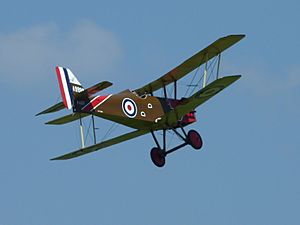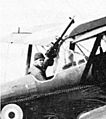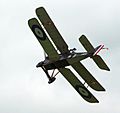Royal Aircraft Factory SE-5 facts for kids
The Royal Aircraft Factory SE-5 was a very important British fighter plane. It had one engine and two main wings, which means it was a biplane. This aircraft was used during World War I. The Royal Flying Corps, which was the British air force at the time, started using it in March 1917. The SE-5 quickly became one of the best fighter planes of its era.
Contents
What Made the SE-5 Great?
The SE-5 was known for being strong and easy to control. Pilots liked it because it was stable, which made it easier to aim and shoot. It was also quite fast and could climb high into the sky quickly. These features made it a tough opponent for enemy planes.
Design and Features
The SE-5 had a powerful engine that gave it good speed. It was usually armed with two machine guns. One was a Vickers machine gun that fired forward through the propeller. The other was a Lewis gun mounted on the top wing, which could fire over the propeller. This setup gave pilots a lot of firepower.
The plane's design also allowed pilots to see well from the cockpit. This was very important in dogfights, where pilots needed to spot enemy planes quickly. Early versions had a high seat, but this was changed to a lower, more comfortable position.
Who Flew the SE-5?
Many famous pilots of World War I flew the SE-5. These pilots were often called "aces" because they had shot down many enemy aircraft. One of the most famous pilots who flew the SE-5 was Albert Ball. He was a very brave and skilled pilot. Another famous ace was James McCudden, who also achieved many victories in the SE-5.
These pilots helped the SE-5 gain a reputation as a very effective fighter. It helped the British air force gain control of the skies during the war.
The SE-5 in World War I
When the SE-5 first appeared in 1917, it helped change how air battles were fought. Before the SE-5, some British planes were not as good as the German ones. But the SE-5, along with other new planes, helped the British pilots compete better.
It was used for many different missions. These included fighting enemy planes, protecting bombers, and watching enemy movements from above. The SE-5 was a key part of the air war on the Western Front.
After the War
After World War I ended in 1918, many SE-5 planes were no longer needed. Some were sold to other countries, and a few were used for civilian purposes. Today, you can see replicas of the SE-5 in museums and at airshows. These replicas help us remember the important role this aircraft played in history.
Images for kids
-
S.E.5a aircraft of No. 32 Squadron RAF. The wartime censor scratched out the serial numbers but left the squadron markings.
-
James McCudden's S.E.5a (200 h.p. geared Hispano-Suiza with 4-bladed propeller) of No. 56 Squadron RAF.
-
Albert Ball in S.E.5 with original windscreen and seating position
-
Pilot in the cockpit. Note the forward-firing .303 in (7.7 mm) Vickers and Lewis machine guns
See also
 In Spanish: Royal Aircraft Factory S.E.5 para niños
In Spanish: Royal Aircraft Factory S.E.5 para niños













